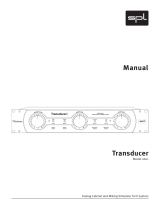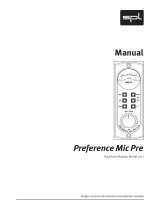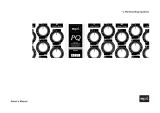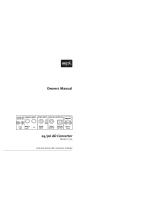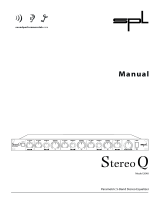Page is loading ...

Manual
Analog Dual-Channel Volume Controller
4PVOE1FSGPSNBODF-BC
.VUF
.PEFM
%VBM$IBOOFM7PMVNF$POUSPM
Volume 2
Model 2602

2
Volume 2
Version 1.0 – 5/2006
Designer: Wolfgang Neumann
This user's guide contains a description of the product. It in no way repre-
sents a guarantee of particular characteristics or results of use. The informa-
tion in this document has been carefully compiled and verifi ed and, unless
otherwise stated or agreed upon, correctly describes the product at the time
of packaging with this document.
Sound Performance Lab (SPL) continuously strives to improve its products
and reserves the right to modify the product described in this manual at any
time without prior notice. This document is the property of SPL and may not
be copied or reproduced in any manner, in part or fully, without prior authori-
zation by SPL.
SPL electronics GmbH
Sohlweg 55
41372 Niederkruechten
Germany
Tel. +49 (0)2163 983 40
Fax +49 (0)2163 983 420
Email: info@soundperformancelab.com
www.soundperformancelab.com
CE Declaration of Conformity
Manufacturer: SPL electronics GmbH
Type of Equipment: Audio Signal Processor
Product: Volume2, Model 2602
Compliance Engineer: Wolfgang Neumann
Test Basis: EN50081-1:1992, EN50082-1:1992, EN60065:1993, EN61000-3-
3:1995, EN60065:2002, EN55013:2001, EN55020:2002, EN61000-3-2:2000,
73/23 EWG; 93/68 EWG.
We herewith declare, that the construction of the Volume2, Model 2602, is in
compliance with the standards and regulations mentioned above.
WEEE Registration: 973 349 88
© 2006 SPL electronics GmbH. All rights reserved. Names of other companies
and their products are trademarks of their respective owners.
Manual Volume 2, Model 2602

3
Volume 2
Introduction ............................................................................................... 4
Installation and Security Advices .............................................................. 5
Power Supply .............................................................................................. 5
Rear Panel .................................................................................................. 6
Power Supply, ON/Off Switching ................................................................ 6
Rear Panel Graphic, Signal Connections, XLR Pin Wiring ............................. 6
Operation ................................................................................................... 7
Volume Control ........................................................................................... 7
Calibrating the Monitoring System ............................................................. 7
Mute ........................................................................................................... 7
Specifi cations ............................................................................................ 8
Measurements ........................................................................................... 9
Guarantee & Product Registration ............................................................. 11
Contents

4
Volume 2
The Volume Controller Volume 2 serves as a system-independent analog
volume regulator in all areas of audio processing and playback, including
• Stereo music production
• Movie and video post production, video computer games production
• Demanding hi-fi delity applications
Complementing the fully equipped SPL Stereo Monitoring Controller (MTC
2381), the Volume 2 focuses exclusively on the highest possible quality in
active volume control. Users who do not need additional monitoring function-
ality provided by the MTC 2381 will fi nd the Volume 2 an cost-effective solution
without compromises. The Volume 2‘s design is based on active switching to
avoid nonlinear frequency response introduced by impedance changes with
passive designs when changing levels.
Who needs analog level control?
Simply put—most DAW (Digital Audio Workstation) users. A majority of D/A
converters and sound cards provide nothing in the way of analog level moni-
toring control, and this means the necessity of varying signal levels at the
converter outputs. The result is a lowered bit rate in the monitoring signal,
which can lead to commensurate loss of audio quality.
A further, very interesting application area is in the construction of a straight,
audiophile-quality stereo playback chain, where the Volume 2 is situated
between the playback machine and either power amp and speakers or simply
active speaker system. In such cases, the playback machine must offer analog
outputs. This provides for minimal fi nancial and electronic efforts through the
most direct possible playback path.
Additional Reasons for employing the Volume 2
• High quality balancing stages with extremely good common mode rejection
(minimize interferences and disturbances in the signal paths)
• The mute switch allows for very fast reaction times in cases where loud
speakers or ears should be protected (for example, with computer crashes)
• Users of analog summing without monitoring facilities can cost effectively
improve their systems
Special Features
The Volume 2 is built only with analog circuitry and performance, and its high
quality parts in sophisticated circuitry design are prerequisites to superior
audio quality:
• High end volume potentiometer and illuminated mute switch from ALPS; the
potentiometer controls signals directly (without VCA or DAC circuitry)
• Balanced XLR in- and outputs
• A high quality power supply with toroidal transformer
• Massive, 45 mm diameter aluminum knobs ensure consistent, refi ned
handling
• The elegant, compact format housing (215 x 80 mm or 8.5 x 3.1 inch) allows
for fl exible desktop positioning near or under a computer monitor or gener-
ally saving space in positioning
Introduction

5
Volume 2
Please Read this Important Note:
Be very careful to check that the rear chassis power selection switch is set
to the correct local line voltage position (either 230 or 115 volts) before using
your machine!
Before connecting any equipment make sure that any machine to be
connected is turned off (on the Volume2 rear panel the power switch must be
pushed down).
Turning the Volume 2 on and off: The Volume 2 should always be the fi rst to
be turned on before either power amp or active loudspeaker. In powering
down the reverse should take place (fi rst turn off amps/speakers followed
by the Volume 2). In connecting any cables be sure that the Volume 2 and all
machines affected are turned off.
It makes good sense to think about where you place the unit before connecting
it. It should be positioned so that you can easily reach it, but there are other
considerations. Try not to place it near heat sources or in direct sunlight, and
avoid exposure to excessive vibrations, dust, heat, cold or moisture. It should
also be kept away from transformers, motors, power amplifi ers and digital
processors.
• Do not open the case. You may risk electric shock and damage to your equip-
ment.
• Leave repairs and maintenance to a qualifi ed service technician. Should
foreign objects fall inside the case, contact your authorized dealer or
support person.
• To avoid electric shock or fi re hazards, do not expose your unit to rain or
moisture.
• If the danger of lightning is foreseeable, unplug the unit. Never touch a
power cable during a thunderstorm—danger of life!
• Always unplug the cable by pulling on the plug only; never pull on the
cable.
• Never force a switch or knob.
• Use a soft, lint-free cloth to clean the case. Avoid cleaning agents as they
may damage the unit. if necessary, use an acid-free cleaning oil instead.
The power supply was carefully engineered to provide clean and consistent
current – an important prerequisite for excellent audio. Built around a toroidal
transformer, the power supply generates a minimal electromagnetic fi eld with
no hum or mechanical noise. The output side is fi ltered by an RC circuit to
extract noise and hums inherent in commercial AC power.
All audio-related components are fed by two separate voltage regulators to
minimize disturbance from other components.
An AC power cord is included for connection to the standard 3-prong IEC
connector. The transformer, power cord and IEC connector are VDE, UL and
CSA approved. The AC fuse is rated at 250 mA (230 V version) or 500 mA (115 V
version).
Installation and Security Advices
Power Supply

6
Volume 2
Rear Panel
.BJOT*OQVU
7
_)[
'VTFN"
7
_)[
'VTFN"
"7*43*426&%&$)0$c-&$53*26&/&1"40673*3
3*4,0'&-&$53*$4)0$,
%0/0501&/
$"65*0/
7PMUBHF4FUUJOH'VTF3BUJOH
4FSJBM/VNCFS
4PVOE1FSGPSNBODF-BC
/JFEFSLSDIUFO(FSNBOZ
XXXTPVOEQFSGPSNBODFMBCDPN
."%&*/(&3."/:
503&%6$&3*4,0''*3&03&-&$53*$4)0$,%0
/05&9104&5)*46/*5503"*/03.0*4563&
%*4$0//&$5."*/4#&'03&3&.07*/($07&3
5)*4&26*1.&/5.645#&&"35)&%
9-38*3*/(8"3/*/(
3*()5 *O0VU -&'5 *O0VU
1*/$0/'*(63"5*0/0'9-3$0//&$5*0/4
1*/(/%1*/)051*/°$0-%
&-&$530/*$"--:#"-"/$&%
*/1654"/%0651654E#
7
1JOXJSJOH9-3DPOOFDUPST
(/%IPUDPME
Power Supply, On/Off Switching
Be sure before connecting the Volume 2 to power that the rear-chassis
voltage supply is switched to the proper local rating (either 230 or 115 volts).
Above all, before connecting any machines, always take additional care to
power down all those to be used (and move the rear-chassis power supply
switch of the Volume 2 to the “down“ position).
Finally, always use the following procedure in powering up your assembly:
Always power on your Volume 2 fi rst before the power amp or active
speakers. When powering down, always power off the power amp or active
speakers before your Volume 2. Not following this sequence can result in ear
or speaker damage from high level discharges!
The Volume 2 comes with a standardized 3-pole (grounded) IEC power cord
which is connected to the main power input socket (Mains Input). The trans-
former, cable and socket conform to VDE, UL, and CSA requirements. The
actual power ratings are 250mA at 230 volts and 500mA at 115 volts.
Balanced right and left XLR Inputs to provide for stereo source connections.
The nominal signal level is at +4 dB, other levels will be transmitted 1:1.
Balanced right and left XLR Outputs to provide for connections to power
amps or active speakers.

7
Volume 2
Volume Control
The single volume potentiometer controls volume for both channels. The
audio signal is controlled directly by the potentiometer—thus no VCA or DAC
regulators in the paths which tend to produce bigger tolerances and distor-
tions.
The scale of this control has been purposely marked in percentage rather than
in dB values. A dB scale would not make too much sense because we cannot
plan for absolute values in signal level reproduced by individual systems and
in playback rooms.
Calibrating the Monitoring System
Both the signal level which is send to the Volume 2 controller as well as the
input sensitivity of the power amps or active speakers should be matched to
ensure a proper overall gaining. An inappropriate adjustment might happen
when, for example, a (fairly small) 10% volume level setting might already
result in an extremely high playback level.
Important: You can encounter very loud signals during calibration, so be sure
to keep your ear protection on. For calibration we recommend measurement
with a Real Time Analyzer (RTA) or a SPL Meter (in this case, SPL translates to
“Sound Pressure Level“). First the measuring machine and microphone are
set up at the listening position. Then one produces in the DAW a sound fi le
with “pink noise”, which is played back and measured.
Each measurement should be done through one channel and loudspeaker
at a time. A recommendable calibration is the playback of a 83db SPL refer-
ence signal at the playback location—a common reference volume level. The
DAW output level should be adjusted to 0 dB, and next, the power amp‘s or
active speaker‘s input level should also be set to 0 dB. Now the Volume 2 level
control is adjusted until the RTA or SPL Meter measures 83 dB with the pink
noise playback. For a perfectly matched gaining the Volume Control would
now be set above a 50% scale position. At this point one can record or note
the exact value for 83 dB. Should this 83 dB SPL occur markedly above a 60-
80% scale position, one should lower the power amp’s/active speaker’s input
sensitivity (=higher dB value). On the other hand, the power amp’s/active
speaker’s input sensitivity should be raised if the 83 dB SPL point is reached
far before the 60% control level. In cases where regulating power amp/active
speaker inputs is not enough, one may reach good values by changing the
D/A converter output level (for example from +4 dB to 0 or -10 dB in cases
where this switch option may exist). In any case, the converters should always
be driven at full scale from the DAW.
Mute
You guessed it ... this switch mutes all speaker outputs. It is particularly
valuable in panic situations, for example, if the computer crashes and its
conver ters suddenly output uncontrolled high level noise. It is also ver y useful
in any case where one simply wants silence without changing the Volume
settings—e. g. to answer the telephone.
IMPORTANT: When making any cable connection changes, you should not
only activate the mute switch, but follow the on/off powering procedures
noted on p. 6.
Operation

8
Volume 2
Inputs/Outputs
Instrumentational amplifi er, electronically balanced
(differential), transformerless
Nominal Input Level +4 dBu
Input Impedance =22 kOhm
Output Impedance ‹ 600 Ohm
Max. Input Level › +20 dBu
Volume Gain ∞ bis -4 dB
Measurements
Frequency Range 10 Hz-100 kHz
(100 kHz = -3 dB)
CMRR › 60 dBu@1 kHz
THD & N (@ +15 dBu Input Level) › -100 dBu
S/N A-weighted -102 dBu
Crosstalk L/R (@ 1 kHz) › -80 dBu
Dynamic Range 120 dB
Power Supply
Toroidal transformator 3,5 VA
Fuse 250 mA/230 V, 500 mA/115 V
Voltage Selector 230/50 Hz ‹› 115 V/60 Hz
Power Consumption ca. 15 W
Dimensions & Weight
Housing 215 x 80 x 220 mm/
8.5 x 3.1 x 8.8 inches
Depth incl. Potentiometer, Sockets 245 mm/9.8 inches
Weight 1.6 kg/3.52 lb
Notes:
0 dBu = 0.775 V
Subject to change without notice.
Specifi cations

9
Volume 2
Audio Precision 04/27/06 10:01:58Volume 2 FREQUENCY RESPONSE 10db Steps
FREQ RESP only On.at2c
+0
-90
-80
-70
-60
-50
-40
-30
-20
-10
d
B
u
10 200k20 50 100 200 500 1k 2k 5k 10k 20k 50k 100k
Hz
Volume 2
Measurements

10
Volume 2
Audio Precision 04/27/06 09:49:58Volume 2 INPUT/OUTPUT PHASE vs
FREQUENCY
SPL IN-OUT PHA SE.at2c
-150
+150
-100
-50
+0
+50
+100
d
e
g
20 100k50 100 200 500 1k 2k 5k 10k 20k 50k
Hz
Volume 2
Audio Precision 04/27/06 09:47:31Volume 2 FFT SPECTRUM ANALYSIS
+6dB
FFT Stereo.at2c
-140
+20
-120
-100
-80
-60
-40
-20
+0
d
B
V
2.5k 22.5k5k 7.5k 10k 12.5k 15k 17.5k 20k
Hz
Volume2
Measurements

11
Volume 2
All SPL products come with a two-year manufacturer’s guarantee against
defects in material or assembly from the date of purchase. Tubes have a guar-
antee of three months.
End users are supported in the two-year guarantee through their distributor.
In such cases, please contact your dealer for full guarantee conditions and
service.
Direct SPL product support requires product registration. Please fi ll out the
guarantee card enclosed in the package legibly in printed letters and send
it directly to SPL. Or use the online registration form that may be reached at
www.soundperformancelab.com (international clients) or www.spl-usa.com
(US clients).
Guarantee & Product Registration

12
Volume 2
Manual Volume 2
< English
/
